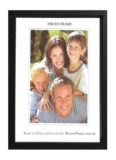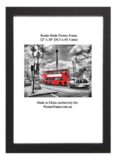![]() Why this post "On framing wrinkled, creased, crinkled and dog-eared maps"? This is because, and as we have mentioned before, many of our posting ideas come from
Why this post "On framing wrinkled, creased, crinkled and dog-eared maps"? This is because, and as we have mentioned before, many of our posting ideas come from interactions with our Customers. And it was by way of jest, that a Customer, having finished the custom picture framing consultation for a couple of brand, new posters, wistfully asked us: " I don't suppose you'd be able to frame old, crinkly, wavy, damaged, maps"? The Customer, smiling, explained that she had another picture framing declined to re-frame a large, old map of hers as it was "impossible" to flatten with their dry-mounting method. We then asked to see the map which the Customer had not yet brought in but had left in the car. On viewing it, we advised the Customer that, yes, we could frame it nor problem and also, that we could mount it perfectly without any of the kinks, creases, ripples and folds now visible under the glass of the old frame.
interactions with our Customers. And it was by way of jest, that a Customer, having finished the custom picture framing consultation for a couple of brand, new posters, wistfully asked us: " I don't suppose you'd be able to frame old, crinkly, wavy, damaged, maps"? The Customer, smiling, explained that she had another picture framing declined to re-frame a large, old map of hers as it was "impossible" to flatten with their dry-mounting method. We then asked to see the map which the Customer had not yet brought in but had left in the car. On viewing it, we advised the Customer that, yes, we could frame it nor problem and also, that we could mount it perfectly without any of the kinks, creases, ripples and folds now visible under the glass of the old frame.
The Customer was naturally enough, puzzled. Why could we take on an do the job while the other picture framer wouldn't? We explained that different framers may use different mounting methods, depending on the equipment, materials, knowledge and experience that they may possess, or have acquired over the years.
So far as we are concerned, we prefer the "wet mounting" method to the the "dry-mounting method". The former method has been previously discussed in Picture framing wizardry and the secrets of mounting and need not be repeated here, however we use it, and have always used it, because we deem it to be superior to other methods. We can thus quite confidently state that that the challenge and difficulties of picture framing wrinkled creased maps hold little fear for us.
By far the greater majority of art brought in by Customers for picture framing consists of is inexpensive, commercial reproductions which require good, permanent and inexpensive mounting, easily achieved by wet mounting the art with a vacuum press.
This wet-mounting process is described in our earlier post Picture framing wizardry and the secrets of mounting which also shows before-and-after images of art on paper being flattened.
However there are other methods and ways to display other types of maps, depending on the use Customers may want to put them. One of these is for the so-called" Pin Maps".
With Pin Maps, as the name implies, these are maps that Customers want to push thumb tacks, pins, or locator pins, into. With these maps, wet-mounting on MDF is not really possible because pins cannot be pushed into this hard material. Instead, these are simply cold-mounted ( or stuck-on ) on self-adhesive foamboard or similar material.
For a special size, or custom size map, a picture frame would then be made and fitted around the mounted pin map. Naturally enough, glazing ( covering the artwork with glass ) is generally not required as this would prevent the placing or insertion of pins.
If the map is of a standard size, then the mounted pin map can easily and cheaply framed into an A2 poster frame or A1 poster frame, depending on the size it is. The flexible tabs at the back of these frames generally flex, or bend, enough to accommodate the standard thicknesses of 3 and 3mm foamcore, or foamboard.
Scratchie Maps are also brought in for framing from time to time. In a way, this is a variant of the push pin maps. Instead of pushing pins into spots in a map, specific sections are scratched off, these being most often the cities, locations or locations, which Customers visited.
These maps are framed much the same way as normal, paper-borne maps, by vacuum-pressing these in the manner described in the aforementioned post. Perhaps the only variation is that Customers may not want these glazed ( covered with glass ) which results in a lighter and cheaper custom picture frame.
For those who have a non-standard size map, or other artwork, and need a custom-size picture frame for it, please visit our our Made-To-Order Frame Kits to place an order.
Antique Maps, or precious, heirloom, valuable or limited edition maps are also brought in from time to time to be picture framed. With such items, ready-made picture frames generally will not do, largely because the backs of these frames are almost always acidic, tending to burn and "yellow" artwork.
Neither would we permanently glue them down because this process is also acidic and non-reversible. We would always recommend, at the very least, Acid-Free Standard custom picture framing.
Jigsaw puzzle maps are another type of map although these rarely become creased because the puzzle tiles, or tabs, at around 1 to 2mms, are generally too thick to bend. All types of jigsaw puzzles became a really popular pastime during the variously mandated government COVID-lockdowns. After the lifting of these restrictions we experienced a steady trickle of Customers bringing thEse in for picture framing. Despite some belief to the contrary, jigsaw maps can be simply, durably and inexpensively framed.
On or our previous posts Taking the puzzle out of jigsaw puzzles details which largely relates to the custom picture framing of jigsaw puzzles. However not all ap puzzles, or any jigsaw puzzle for that matter, need to be custom framed. If the puzzle size is of a standard size it can simply be fitted into a ready made frames, such an A2 picture frames below:
 Original Maps are, in our experience, any maps, whether new, or old, that have some hand-drawn, hand-designed, hand-made or unique, one-off features about them. Such a map might well be a nautical one which grandfather drew during his Navy service, or it might be an adolescent's high school cartographic assignment, or any map with visible, hand-drawn ink or colourings which usually tend to indicate that the map has some degree of originality or uniqueness about it.
Original Maps are, in our experience, any maps, whether new, or old, that have some hand-drawn, hand-designed, hand-made or unique, one-off features about them. Such a map might well be a nautical one which grandfather drew during his Navy service, or it might be an adolescent's high school cartographic assignment, or any map with visible, hand-drawn ink or colourings which usually tend to indicate that the map has some degree of originality or uniqueness about it.
Since an original map may well have a historical, financial, or personal connection or value to or for the Customer, acid-free picture framing is the very least picture framing standard we would recommend, and in the case of vintage or antique maps, a specialist art conservator should be consulted before picture framing.
The reason for this suggestion is that only a trained and qualified professional can accurately assess and evaluate the state and condition of the artwork and gauge if it is fit to be framed. Often, preventive or curatorial processes may be required to stabilize the media or stratum, and to prevent or to forestall unseen problems, such as latent friability or impending deterioration.
Thank you for reading this post "On framing wrinkled, creased, crinkled and dog-eared maps".









Amazing! So that’s why photos and prints get wavy under the glass! It’s got nothing to do with the frame, it’s just that the paper isn’t stuck or glued doon and so it moves with the heat and the weather. Thank you for explaining all that, and how it can be fixed. I always wondered why it was happening.